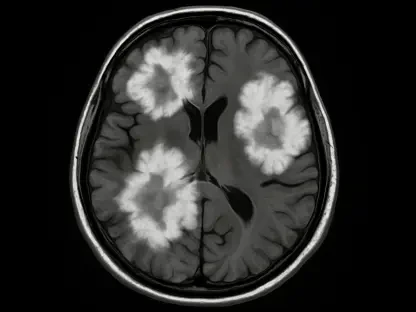In the heart of rural Kansas, a disturbing trend is unfolding as hospitals, grappling with severe financial constraints, are taking legal action against patients over unpaid medical bills, often for amounts that seem shockingly small to warrant such measures, thrusting families into courtrooms and spotlighting a systemic crisis. This practice has forced families like Sarrah and Kyle Miller of Medicine Lodge into legal battles over a mere $230 debt, highlighting a deeper struggle that pits the survival of healthcare institutions against the well-being of the very communities they serve. Their story is far from isolated, as thousands of residents across the state face similar lawsuits, revealing a profound issue within rural healthcare systems. The financial desperation of hospitals, combined with the burden on patients already stretched thin, paints a stark picture of a broken framework where essential care comes at a steep personal cost. This issue demands attention, not only for the immediate impact on individuals but also for the broader implications on community trust and access to medical services.
Examining the Financial Crisis of Rural Healthcare
Pressures Leading to Hospital Closures
Rural Kansas hospitals are caught in a relentless economic bind, with a staggering 67% at risk of closure, placing them among the most vulnerable in the nation. Many of these facilities operate at a loss, burdened by negative operating margins, such as the -2% margin reported by Newman Regional Health in Emporia. Low patient volumes, especially in sparsely populated areas, mean fewer opportunities to generate revenue. Compounding this challenge are reimbursement rates from public insurance programs that fall short of covering costs—Medicaid reimburses just 65 cents on the dollar, while Medicare offers 80 cents. With a smaller share of privately insured patients compared to urban centers, these hospitals lack the financial cushion to absorb losses. The constant threat of shutting down essential services drives administrators to adopt aggressive debt collection tactics, including lawsuits over minimal amounts, as a means to stay afloat.
Beyond the numbers, the reality of potential closures carries profound consequences for rural communities. If a hospital shuts its doors, residents may need to travel significant distances—often 20 to 40 miles—to access care, a burden that can delay treatment and worsen health outcomes. Administrators argue that every unpaid bill, no matter how small, chips away at their ability to maintain operations. The fear of cutting critical services, such as emergency rooms or maternity wards, looms large, pushing these institutions to prioritize financial recovery over leniency. This precarious balance underscores why legal action has become a survival tool, even as it alienates the very people who depend on these facilities for their health and well-being.
Rationalizing Legal Measures for Debt Recovery
Hospital leaders and their legal counsel often frame lawsuits as an unavoidable step to safeguard their institutions’ future. Before resorting to court, many facilities implement a series of measures, such as offering payment plans and allowing extended periods—sometimes up to 240 days—for patients to settle their debts. Legal representatives, like Todd Butler, contend that targeting smaller claims is not only practical but also necessary to establish a culture of accountability among patients. These smaller debts are often easier to collect compared to larger sums, providing a quicker influx of funds that can help offset millions in uncompensated care costs reported annually by some hospitals. For rural facilities with razor-thin budgets, this approach is seen as a critical lifeline.
However, this justification is not without its complexities. While hospitals assert that they exhaust all other options before filing suits, the sheer volume of cases—over 2,600 lawsuits by Newman Regional Health in a single year, many for under $500—suggests a systemic reliance on litigation as a revenue stream. Administrators like Cathy Pimple of Newman Regional emphasize that without such measures, the risk of service reductions or complete closures becomes imminent. Yet, this aggressive stance often overlooks the unique nature of medical debt, which differs from other financial obligations as it is rarely a choice. The tension between fiscal necessity and ethical considerations remains a central debate in understanding why rural hospitals lean so heavily on legal recourse.
The Human Cost of Medical Debt Litigation
Economic and Emotional Hardship for Patients
The impact of hospital lawsuits on patients in rural Kansas extends far beyond the financial realm, cutting deep into their personal lives with devastating consequences. Families like the Millers, despite having health insurance, find themselves unable to cover unexpected medical expenses, with even modest bills like $230 pushing them into legal battles. The additional costs of court fees and the looming threat of wage garnishment create a suffocating cycle of debt that is nearly impossible to escape. For many, these financial pressures are compounded by the reality that nearly half of Americans, according to national surveys, cannot afford a sudden $500 medical expense. This vulnerability turns a single unpaid bill into a cascading series of hardships that threaten their stability.
Emotionally, the toll is just as severe, as patients grapple with the betrayal of being sued by institutions meant to provide care and comfort. In rural communities, where hospitals are often viewed as trusted neighbors, such legal actions can feel like a personal attack, with some patients describing the experience as akin to being bullied. The stigma of a lawsuit in tight-knit areas adds another layer of distress, eroding the sense of community support that is so vital in these regions. This emotional strain often leads individuals to question their trust in local healthcare providers, creating a rift that can have lasting effects on how they seek or avoid medical attention in the future.
Wider Community Fallout and Health Access Barriers
The repercussions of these lawsuits ripple through entire rural communities, undermining the social fabric and access to essential care. When a hospital sues its own patients, it risks damaging the trust that binds small towns together, as residents begin to see these institutions as adversaries rather than allies. This erosion of confidence can deter individuals from seeking timely medical treatment, driven by fears of incurring unaffordable bills or facing legal consequences. National data indicates that a significant percentage of people delay care due to cost concerns, often resulting in worsened health conditions that could have been prevented with earlier intervention.
Moreover, systemic challenges amplify the burden on rural residents. Kansas’ decision not to expand Medicaid has left a sizable portion of the population uninsured or underinsured, making even small medical debts insurmountable. The potential closure of local hospitals adds another barrier, forcing patients to travel long distances for care, which is both costly and time-consuming. Rural areas already face higher rates of premature death due to limited healthcare access, and the combination of financial fears and reduced services exacerbates this disparity. The community-wide impact of litigation thus becomes a public health concern, as the immediate financial gains for hospitals may come at the expense of long-term well-being for the population they serve.
Missed Opportunities in Patient Support Systems
Underutilization of Charity Care Programs
A critical factor fueling the cycle of lawsuits in rural Kansas is the apparent underuse of charity care programs designed to assist patients in financial distress. Federal guidelines mandate that hospitals inform individuals about options for discounted or free care based on their inability to pay, yet implementation often falls short. Data reveals that some facilities allocate less than 1% of their operating expenses to charity care, a stark contrast to the potential need within their communities. This low utilization suggests that many patients who might qualify for assistance are either unaware of these programs or not adequately guided through the application process, leading to unnecessary legal confrontations over debts that could have been mitigated.
The lack of effective outreach and education about charity care options represents a missed opportunity to break the cycle of medical debt litigation. Experts argue that if hospitals invested more in communicating these resources—through clear notifications, accessible applications, or community partnerships—fewer patients would face the threat of lawsuits. The personal stories of families like the Millers highlight how a simple conversation about available aid could have altered their trajectory, sparing them the stress and cost of court proceedings. Addressing this gap could serve as a bridge between the financial needs of hospitals and the economic realities of their patients, reducing reliance on aggressive collection tactics.
Ethical Concerns Over Debt Collection Practices
Criticism of hospital practices in rural Kansas often centers on the ethical implications of suing patients over medical debt, particularly when communication about assistance falls short. Legal advocates point out that many individuals are caught off guard by lawsuits, having never been informed of charity care or payment relief options that might have resolved their debts without litigation. This lack of transparency raises questions about whether hospitals are prioritizing revenue recovery over their mission to serve the community, especially since medical debt is often an involuntary burden, unlike other forms of financial obligation. The ethical debate hinges on whether such legal actions are justifiable given the unique circumstances surrounding healthcare costs.
Furthermore, the scale and approach of these lawsuits draw scrutiny for their perceived harshness. With thousands of cases filed annually, often for amounts under $500, critics argue that the resources spent on legal proceedings might outweigh the recovered funds, especially after accounting for court costs. Advocates for patients emphasize that the involuntary nature of medical expenses calls for a different standard of debt collection—one that prioritizes empathy and support over punishment. This perspective challenges hospitals to rethink their strategies, suggesting that investing in patient education and flexible payment solutions could preserve community trust while still addressing financial needs, avoiding the moral pitfalls of litigation.
Systemic Failures and Rural Healthcare Disparities
Structural Policy Shortcomings
The wave of hospital lawsuits in rural Kansas cannot be fully understood without examining the broader policy failures that underpin the crisis. The state’s refusal to expand Medicaid stands as a significant barrier, leaving a substantial number of residents uninsured or underinsured, and increasing the burden of uncompensated care on hospitals. Coupled with looming federal funding cuts projected to reduce Medicaid support by billions over the next decade starting from 2025, rural facilities face an ever-tightening budget. Lower reimbursement rates for these hospitals compared to urban counterparts further strain their finances, creating an environment where aggressive debt collection becomes a desperate measure to offset losses.
These structural issues highlight a disconnect between policy frameworks and the realities of rural healthcare. Without expanded coverage or improved funding mechanisms, hospitals are left with few options to absorb the costs of unpaid bills, pushing them toward litigation as a stopgap solution. The lack of legislative protections against medical debt penalties, such as preventing credit score damage or wage garnishment, adds to the vulnerability of patients. Addressing these policy gaps through targeted reforms—whether through state-level Medicaid expansion or federal incentives for rural healthcare—remains a critical step to alleviate the pressures driving lawsuits and to ensure that essential services remain accessible to all.
Long-Term Impacts on Rural Communities
The disparities in rural healthcare access compound the challenges posed by hospital lawsuits, with long-term consequences for community health and economic stability. When rural hospitals close due to financial insolvency, residents must travel significantly farther—often 20 to 40 miles—for medical care, a burden that can delay emergency treatment and routine checkups alike. Remaining facilities, under pressure to stay solvent, may raise prices, further limiting affordability for those already struggling with medical debt. Staffing shortages in these areas also hinder the ability to provide comprehensive care or engage in proactive patient outreach about payment options, perpetuating the cycle of unpaid bills and legal action.
Additionally, the health outcomes in rural Kansas reflect the toll of these systemic barriers, with higher rates of premature death linked to limited access to timely care. The combination of financial fears, driven by lawsuits, and physical barriers, due to closures, creates a public health crisis that extends beyond individual families to entire regions. Rural communities, often already economically disadvantaged, face a compounded struggle as medical debt contributes to bankruptcy and reduced quality of life. Breaking this cycle demands a multifaceted approach, integrating policy reform with community-focused initiatives to bolster hospital finances without sacrificing patient well-being, ensuring that healthcare remains a right rather than a legal battleground.
Reflecting on Paths Forward for Rural Healthcare
Lessons from a Systemic Struggle
Looking back on the crisis of hospital lawsuits in rural Kansas, it becomes evident that the clash between institutional survival and patient hardship stems from deep-rooted systemic failures. Hospitals, driven to the brink of closure with 67% at risk, resort to legal action over small debts as a desperate bid to maintain operations. Patients, burdened by unexpected costs and inadequate safety nets, bear the brunt of this approach through financial ruin and emotional distress. The stories of families like the Millers, alongside staggering lawsuit figures from facilities like Newman Regional Health, paint a grim picture of a healthcare system stretched to its breaking point. Policy gaps, such as the absence of Medicaid expansion, only deepen the divide between community needs and hospital capabilities.
Charting a Course for Reform
Moving forward, actionable solutions must take center stage to address this multifaceted issue. State and federal policymakers should prioritize rural healthcare funding, potentially through programs like the Rural Health Transformation initiative, to provide hospitals with the resources needed to avoid aggressive debt collection. Expanding Medicaid in Kansas could reduce uncompensated care costs, easing the financial strain on facilities while protecting residents from insurmountable bills. Hospitals, in turn, must enhance transparency and outreach for charity care programs, ensuring patients are aware of assistance before lawsuits are filed. Legislative protections against harsh medical debt penalties, such as safeguarding credit scores or limiting wage garnishment, could further shield vulnerable individuals. These steps, combined with community partnerships to educate and support patients, offer a pathway to rebuild trust and ensure that healthcare serves as a lifeline rather than a legal burden.









